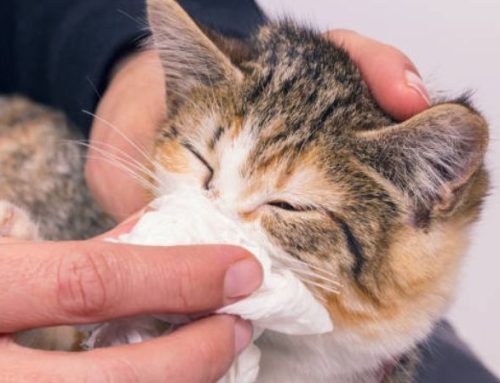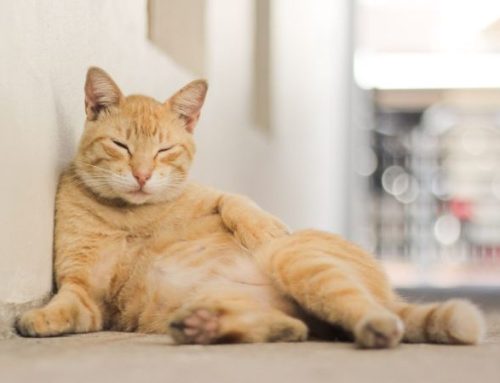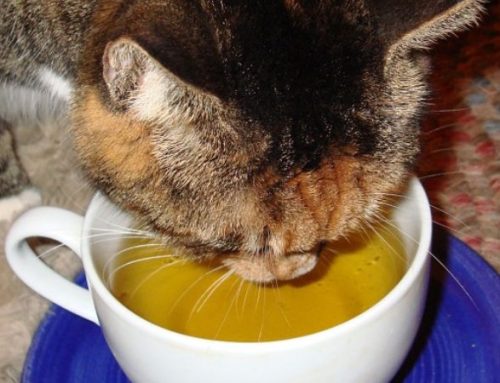Ever peeked at your cat and wondered, “Can I just use what’s in my bathroom to clean this furball?” With so many soaps and body washes lining our shelves, it’s tempting to grab whatever’s handy. But when it comes to feline grooming, not all soaps are created equal and some can actually harm your kitty’s delicate skin.
In this guide, Nexus Pets dives into whether hand soap or Aveeno is safe for cats, along with the best and worst options for keeping your feline’s coat soft, healthy, and happy.
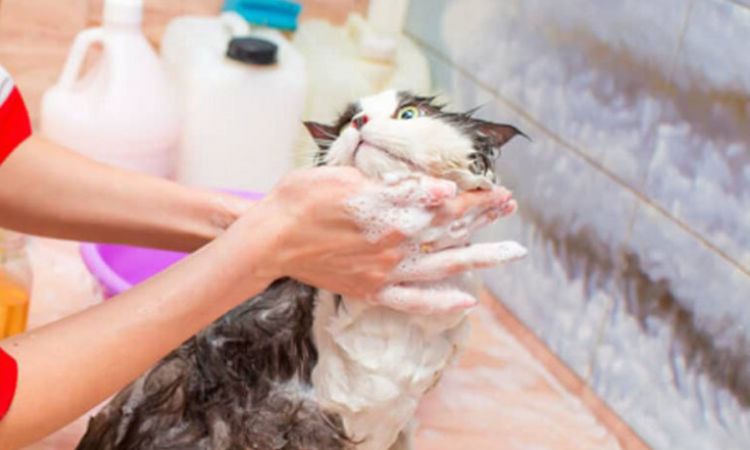
Why Human Soap Is Toxic and Harmful to Your Cat (The “Worst Soaps” Explained)
Why Human Soap Destroys Feline Skin Barriers
One of the primary reasons human soap can wreak havoc on your cat’s skin is due to the significant difference in pH levels between humans and cats. Human skin typically has a slightly acidic pH, hovering around 5.5, which is ideal for the skin’s natural barrier. However, cats have a much more neutral pH range for their skin—between 6.5 to 7.5. This means their skin is more sensitive to acidic or alkaline substances.
Human soaps, which are designed to be more acidic, often have a pH level that’s too harsh for cats. When you use human soap on your cat, the acidic or alkaline content strips away their skin’s natural oils, which are essential for maintaining a healthy skin barrier. Without these protective oils, your cat’s skin becomes dry, irritated, and vulnerable to infections like dermatitis. Over time, repeated exposure to inappropriate soaps can lead to chronic skin issues, including rashes, hair loss, and even painful sores.
The Hidden Dangers of Perfumes, Detergents, and Essential Oils
Another reason why human soap is a no-go for cats is the presence of potentially toxic ingredients commonly found in products like Aveeno, Dawn, and other hand soaps. These ingredients may smell pleasant to us, but they pose hidden dangers to your feline companion.
- Sulfates and Parabens: Commonly found in many human soaps, sulfates like sodium lauryl sulfate are surfactants designed to create lather. However, these chemicals can be incredibly irritating to a cat’s delicate skin. Parabens, used as preservatives in many soaps, can cause allergic reactions and further contribute to skin irritation.
- Essential Oils: While essential oils may provide a refreshing scent, they can be toxic to cats, especially in concentrated forms. Oils like lavender, tea tree, and eucalyptus—frequent ingredients in human soap—can cause severe toxicity if ingested or absorbed through the skin. Cats lack the enzymes needed to break down these oils, making them highly susceptible to poisoning. If a cat licks soap residue off their paws or fur, they could ingest a harmful dose of these oils, leading to symptoms such as drooling, vomiting, lethargy, and even liver damage in severe cases.
Why These Specific Products Must Be Avoided
It’s clear that using human soaps, such as Aveeno or popular dish soaps like Dawn, on your cat poses significant health risks. The pH imbalance, harsh detergents, and toxic essential oils make these products unsafe for feline skin. Even mild-sounding soaps like Aveeno, which are often marketed as gentle, contain ingredients that could irritate your cat’s sensitive skin or cause internal toxicity if licked. The risks far outweigh any convenience, and using these soaps on your cat could lead to ongoing health issues.
Instead, always choose pet-specific products that are pH-balanced for feline skin and free from harmful chemicals. These products are formulated to be gentle, non-toxic, and safe for your cat to groom, ensuring their skin and coat remain healthy without the risk of irritation or toxicity. Remember, when it comes to your cat’s well-being, it’s always better to play it safe and go with products designed for their specific needs.
What Shampoo Should I Use On My Cat? (Veterinarian-Approved Alternatives)
Choosing the right product to clean your cat isn’t just about removing dirt it’s about maintaining their skin’s natural balance, keeping their coat healthy, and preventing irritation or allergic reactions. Many pet owners wonder: what should I bathe my cat with? or what soap can I safely use on cats? The truth is, cats are sensitive to human soaps and even some dog shampoos, which can strip essential oils or trigger reactions. Below, we break down veterinarian-approved options that cater to a variety of feline needs, ensuring a safe and stress-free bath every time.
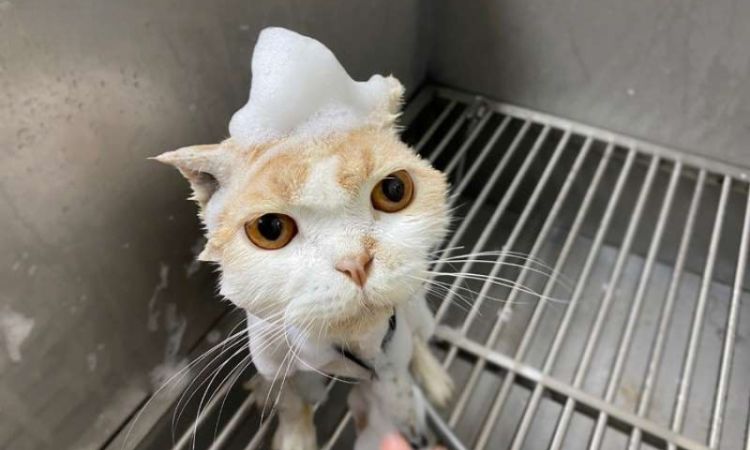
Option 1: General-Purpose, pH-Balanced Feline Shampoos
For most cats, a gentle, everyday shampoo is sufficient to maintain a clean and healthy coat. Look for products that are specifically formulated for cats or kittens and labeled as soap-free and tearless. These shampoos are designed to match the natural pH of feline skin, avoiding dryness and irritation that human soaps can cause.
Recommended Ingredients:
- Oatmeal: Soothes sensitive or itchy skin
- Aloe Vera: Moisturizes and promotes healing
- Vitamins and natural extracts: Support coat shine and overall skin health
These shampoos answer the common question, what shampoo should I use on my cat?, providing a safe, daily-use option for both short-haired and long-haired breeds.
Option 2: Medicated and Specialty Shampoos (Vet Recommended)
Sometimes your cat requires more than a gentle wash. Medicated shampoos are essential for treating conditions such as:
- Flea infestations
- Severe dander or allergies
- Ringworm or fungal infections
- Other dermatological concerns
These formulas often contain active ingredients not found in general-purpose shampoos. Because of this, it’s critical to consult your veterinarian before use, as inappropriate application can cause harm or worsen the condition.
By selecting the right medicated shampoo under veterinary guidance, you can effectively target the root cause of skin issues while keeping your cat safe and comfortable.
Option 3: Waterless and Foaming Cleansers (The Low-Stress Choice)
For cats who absolutely hate baths—which, let’s face it, is most felines—waterless or foaming cleansers offer a practical alternative. These products are applied directly to the coat, massaged in, and then towel-dried, eliminating the need for a full bath with water.
Best for:
- Elderly or arthritic cats
- Cats with anxiety around water
- Quick touch-ups between full baths
Waterless cleansers are gentle, pH-balanced, and can be used frequently without damaging your cat’s natural oils, making them a low-stress solution for maintaining hygiene and reducing odor.
The 5-Step Guide to a Low-Stress Cat Bath
Preparation is Everything: Supplies and Environment
The key to a successful cat bath lies in setting up the right environment and having all the necessary supplies within reach before starting. A cat that’s already in the water might become more stressed if you have to leave the room to fetch something.
Key Preparations:
- Trim Your Cat’s Claws:
Trimming your cat’s nails before bath time reduces the risk of being scratched when your cat becomes anxious or tries to escape. If you’re not familiar with trimming cat nails, it’s best to use proper cat nail clippers and trim only the sharp tips. This will also help avoid any accidental cuts or scrapes during the process. - Secure the Bathroom:
Cats are great escape artists, and you don’t want your cat running around wet and slippery in a panic. Before bringing your cat into the bathroom, close the door or use a bathroom gate to keep them in the designated space. This will prevent any escape attempts, especially if your cat gets a little frantic. - Water Temperature Matters:
Always check the water temperature before placing your cat into the sink or tub. Cats are sensitive to temperature, and water that’s too hot or too cold can be uncomfortable or even harmful. The ideal water temperature for a cat bath is lukewarm just warm enough that it’s comfortable for you when you dip your hand in.
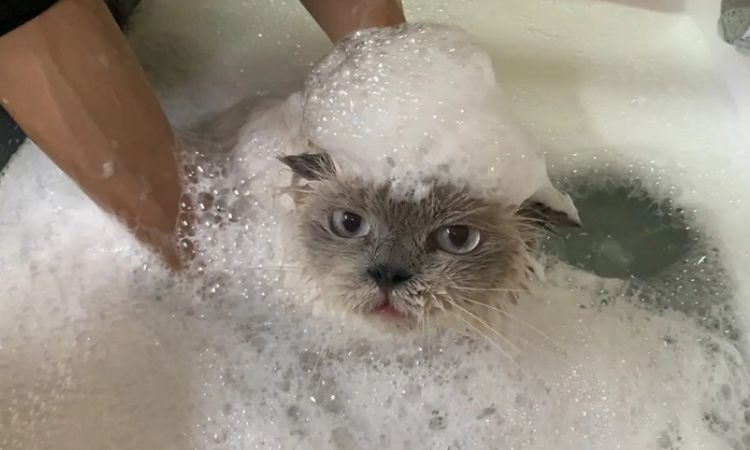
Essential Gear:
- Rubber gloves: These will not only help you handle your cat more securely, but they also provide some protection from scratches.
- Cat-safe shampoo: Never use human or dog shampoo, as it can irritate your cat’s skin. Choose a gentle, tear-free, and hypoallergenic formula designed specifically for felines.
- Towels: You’ll need at least two towels—one for drying your cat off after the bath and another to place in the tub or sink to prevent slipping.
The Washing Technique: Lathering and Avoiding the Head
Once you’ve prepped your cat and the bathing area, it’s time to begin the bath. The goal is to keep your cat as calm and comfortable as possible while ensuring you clean them thoroughly. Here’s how to safely wash your cat, starting from the neck down:
Step-by-Step Washing:
- Wet Your Cat Gently:
Start by wetting your cat’s fur gently. You can use a detachable shower head, a pitcher, or even a small cup to pour warm water onto their body. Be cautious around their face and ears, as most cats don’t like water in these sensitive areas. Focus on wetting their body and tail first, working your way from the neck down. - Apply the Shampoo:
Squeeze a small amount of cat-safe shampoo onto your hands and lather it into your cat’s fur. Start from the neck and work down the body, using gentle but firm strokes. The fur on your cat’s back and tail is the easiest to lather, so focus there first. Avoid getting the shampoo in their ears, eyes, or mouth—cats don’t like having soap in these areas, and it can irritate their sensitive skin. - Massage Gently:
Massage the shampoo into their coat, ensuring it gets all over their body, including the paws, legs, and underbelly. Use the time to check for any mats or tangles, especially in long-haired cats. If needed, use a comb to gently detangle the fur, but be careful not to pull too hard. - Avoid the Face:
The face is a sensitive area for cats. Instead of applying shampoo to their face, use a damp washcloth to wipe around their eyes and whiskers. Be careful not to get water into their ears or eyes, as this can be very uncomfortable and difficult to remove.
Why Thorough Rinsing Is Essential
One of the most critical steps in bathing your cat is making sure you rinse all the shampoo out of their fur. Leftover soap residue can irritate your cat’s skin, causing itching, dryness, or even allergic reactions. Here’s how to make sure the rinse is done effectively:
Why Rinsing Matters
Shampoo residue on your cat’s fur can cause skin irritation, flakiness, or a dull, greasy coat. This is especially important for cats with sensitive skin or allergies. If the shampoo isn’t properly rinsed out, it can lead to itching or redness, which might cause your cat to scratch excessively and further irritate their skin.

Tips for Effective Rinsing
- Use a Detachable Shower Head or Cup:
The most efficient way to rinse your cat is with a detachable shower head or a cup that allows you to pour water gently over their fur. This will help you control the water flow and reach all parts of their body. - Check for Residue:
As you rinse, be sure to pour water over your cat until the water runs clear, with no soap bubbles remaining. You may need to repeat the rinsing process a few times to make sure every last bit of shampoo is removed. Be especially careful around the tail and underbelly, as these areas tend to hold soap longer. - Drying the Fur:
After thoroughly rinsing, gently pat your cat dry with a towel. Long-haired cats might need some extra attention to prevent mats and tangles. For a quicker dry, if your cat tolerates it, you can use a blow dryer on a low, cool setting. Just make sure it’s not too hot, and keep the dryer a safe distance away from your cat’s skin.
You may be interested in this topic:
By following these practical steps, you’ll be able to give your cat a thorough, low-stress bath. Preparation is key, and with the right supplies and techniques, you’ll make bath time an easier experience for both you and your feline friend. If your cat is particularly anxious or aggressive during baths, consider consulting with a professional groomer who can provide additional tips or help with the process.


